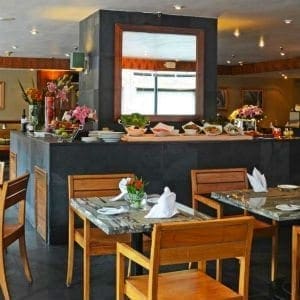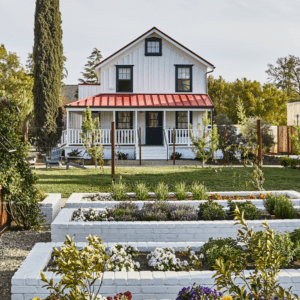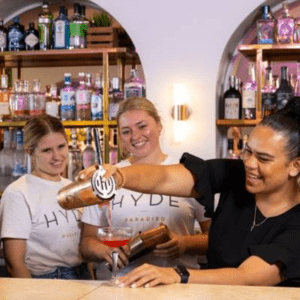 Hotels throughout the USÑproperties large and small, boutique and brandedÑare catering to travelers’ appetites for “local experiences” with food-and-beverage venues that celebrate local ingredients in unique ways. But while the hospitality industry is hyper-focused on this localized fine-dining trend, little attention is paid to the growing popularity of fast-casual dining, the hybrid concept that blends fast-food or quick-service restaurants with casual dining.
Hotels throughout the USÑproperties large and small, boutique and brandedÑare catering to travelers’ appetites for “local experiences” with food-and-beverage venues that celebrate local ingredients in unique ways. But while the hospitality industry is hyper-focused on this localized fine-dining trend, little attention is paid to the growing popularity of fast-casual dining, the hybrid concept that blends fast-food or quick-service restaurants with casual dining.
In fact, the National Restaurant Association found chef-driven fast-casual conceptsÊto be one of its Top 10 Concept Trends for 2017, noting that Òchefs are increasingly exploring the quick-service spaceÓ and Òthe fast-casual restaurant industry has grown explosively in the last decade and shows no signs of slowing down.Ó
Popular fast-casualÊbrands
Unconvinced? The success driving fast-casual dining is often exemplified in the restaurant chains that this concept tends to produce. Wolfgang Puck Express has more than a dozen locations, including one in the Disney Springs Marketplace at Walt Disney World in Florida. Even non-celebrity chefs are getting in on the game; focusing on wholesome dining, Franklin Becker, the chef partner of the Manhattan chain The Little Beet, now has six outlets under the name.
According to David Mansbach, Managing Director at Aethos Consulting Group and founder of the firm’s Chain Restaurant and Hotel Industry Partner Program, Òlocal restaurant chains are going to cause the death of the larger industry. Their focus on regional customers and their passion for producing a quality product are helping to kill larger chains.Ó He points to not a chef-driven concept, but Los Angeles-based Mendocino Farms, a chain of 13 sandwich shops that offer a fast-casual farm-to-table experience.
Social media has contributed to the success of these smaller chains, which can still promote themselves to a targeted audience without the expense of TV and radio ads, which proved an advantage to their nationwide competitive set in decades past. ÒThe internet has really leveled the playing field and allowed brands like New York City-based Mexican chain Dos Toros Taqueria to compete with Chipotle,Ó said Mr Mansbach.
Hotels and fast-casual dining
Leo Kremer, co-CEO of Dos Toros explained that to bring a local or regional fast casual-concept into a hotel and turn it into a profitable venture requires a street-facing location that is high-traffic with a direct street-front entrance and a full cooking hood and kitchen space. ÒHaving a fast-casual brand is a nice amenity for guests because it’s a lot more value-conscious since lunch or dinner will be roughly $10,Ó he said.
But Mr Kremer is also aware that there are constraints for full-service hotels: Fast-casual concepts have limited service and typically, very specialized menus and are not likely to provide room service. Moreover, hotels that offer banqueting services may find that, while many fast-casual brands are capable of catering, corporate clients, too, will have a limited menu from which to choose and perhaps fewer options for meeting dietary restrictions. So MrÊKremer suggested a fast-casual venue as a means of complementing a full-service restaurant, even where catering is concerned. ÒIf you consider a revenue share in the lease, it makes the [fast-casual] restaurant a partner with the hotel, which wouldn’t lose out on banqueting that might go to the fast-casual outlet,Ó he said.
Revenue sharing would also allow the hotel to directly benefit from the volume that these types of restaurants serve while also helping to draw the local community to the hotel, and the hotel’s bars, as the Shake Shack at the Chicago Athletic Association Hotel no doubt does.
The drawbacks
Larry Spelts, VP of Business Development at hotel management company Charlestowne Hotels, is currently working with a client who is contemplating including a local restaurant chain in an upper-upscale hotel that the client is currently developing in downtown Charleston, S.C. ÒThe pro is that this is a solid F&B operator who has experience, a proven track record and a successful concept that’s already been tried and proven,Ó said Mr Spelts. But he still hesitates over how another location of an already familiar concept would be received by locals in addition to a potentially diminished “wow factor” for guests once they realize the restaurant is not unique.
Missed opportunity
Mr Mansbach, however, remains bullish on the idea that more collaboration between local and regional restaurant brands and the hotel industry could be a win-win for both. ÒCustomized models of existing restaurant brands could be created so as to be a huge asset for both and that’s not something that’s being leveraged by leaders on either side of the equation,Ó he said. ÒMany hotels out there are 300 to 500-room, full-service properties that desperately need to improve their F&B and figure out ways to make it more profitable for their hotels and unfortunately, the restaurant industry’s emerging talent isn’t being drawn to the hotel industry where many of the restaurant concepts are homogenized and stale.Ó
By Kerry Medina from Hotel Management



















